2022 World Cup - Tactical Preview. What Can We Expect to See?
- All Angles Football -
- Oct 8, 2022
- 9 min read
In about six weeks, the World Cup returns to grace the eyes of billions of people, with some of the top talents in football. Everyone will have their reasons to watch whether it's to see their favorite player, cheer their team on or just hang with friends and family. But what will I be watching for? Analysis. Tactics. Tactics in our game has and continues to evolve and the World Cup is one of the best demonstrations of this, which you can see in my previous series of World Cup Tactical Trends from 2010, 2014 and 2018. With 2022 right around the corner, I decided to take a deep dive through recent tournaments, technical reports, matches and other resources to get an idea into what tactical trends could emerge or be on show at this winter’s World Cup! Some tactical trends that have been making the rounds in club and international football and could likely be on show in less than six weeks are:
Front 5s
Some of football’s most notable and successful teams in recent years have gotten attention for playing with a front five as a key element of their tactical setup. This front five is usually formed by either:
Wing-backs pushing up high and wide, acting as wingers, to allow forwards to tuck into half spaces (eg. Liverpool through Alexander-Arnold and Robertson)
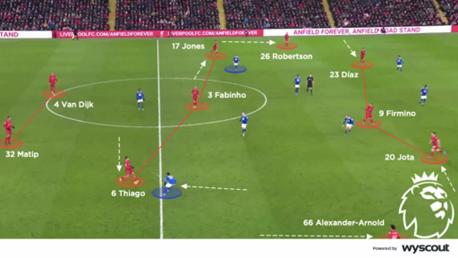
or
Central midfielders (8s) pushing forward into the half spaces (eg. Manchester City through De Bruyne and Bernardo Silva)
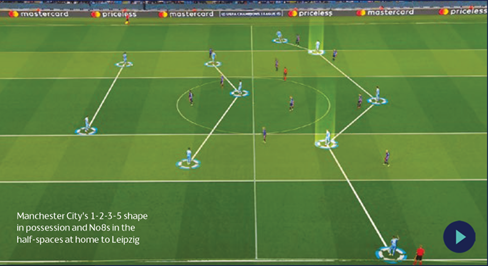
or
A combination of the two mentioned above (eg. Italy through Barella and Spinazzola)

Some teams that have incorporated a front five into their tactical setup in recent years include:
Jurgen Klopp’s Liverpool (4-3-3)
Pep Guardiola’s Manchester City (4-3-3)
Roberto Mancini’s Italy (4-3-3)
Antonio Conte’s Chelsea (3-4-3)
Joachim Low’s Germany in Euro 2020 (3-4-3)
Kasper Hjulmand’s Denmark in Euro 2020 (3-4-2-1)
Xavi’s Barcelona (3-4-3)
Gian Piero Gasperini’s Atalanta (3-4-2-1)
Julian Nagelsmann’s Bayern Munich (4-2-3-1 or 3-4-2-1)
Frank de Boer’s Netherlands (3-4-1-2)
Erik Ten Hag’s Ajax (4-3-3)
This front five is usually utilized as a means of:
creating numerical overloads eg. a 5v4 when facing a back 4
to take advantage of utilizing the half spaces which prove to be a very dangerous area on the field
making the shape of the team as wide as possible when in possession
By occupying all five lanes when in possession this allows teams to be flexible in their approach to bypass opposition defensive lines as they are not only able to play around opponents given the width the front five creates, but additionally, through occupying the half-spaces they are able to also play through the opponent’s channels. Given this tactical element in possession, it should be no surprise that 4 of the teams mentioned above were in the top 5 of minutes per goal in the 2021-22 UEFA Champions League. Bayern, Ajax, Manchester City and Liverpool all were part of the Top 5 for minutes per goal and it is likely no coincidence.
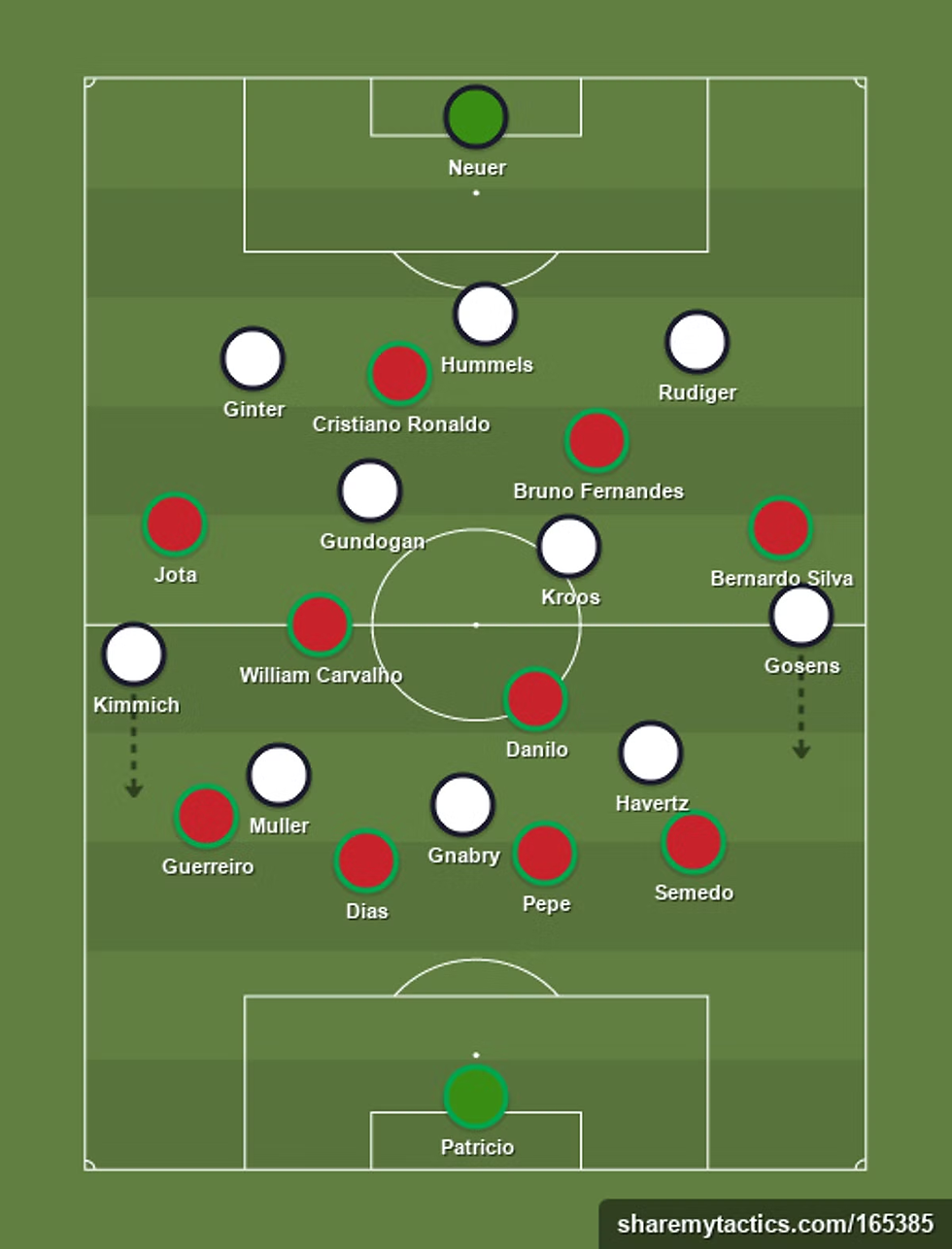
When examining how the front 5 can be beneficial in practice, take for example, Germany vs Portugal in Euro 2020, Low’s Germany utilized their front 5 to create overloads time and time again against the Portugal back 4 which saw the Germans emerge victorious in that game. It is a similar story with Denmark who made a surprise run to the semi-finals and a key part of this was their wing-backs in Maehle and Stryger Larsen who ranked both 2nd and 3rd in chance creation for their team only behind Pierre-Emile Hojbjerg.
It may also be worth noting that some teams such as England, Italy and Denmark even used inverted wing-backs in their front 5s with Spinazzola, Maehle and Trippier all playing as right footed, on the left hand side and this may be worth keeping an eye on in any front 5s in Qatar as inverted wing-backs can create additional and potentially advantageous passing angles, especially when looking to get the ball into the half-spaces. For example, see the picture below from The Athletic.

Take a look at the formations listed above beside the teams mentioned earlier, and see if you notice any patterns/trends before continuing to read.
Answer?
All those teams listed (except Bayern) mainly utilize a 4-3-3 or some variation of a 3-4-3. Formations such as a 4-3-3 or 3-4-3 are really just more of a theoretical/visual element versus the practical and more serve as a guide given the differences in rotations, roles and other elements that formulate a tactical system. However, the 4-3-3 and 3-4-3 share a common theme with the front three that allow a front five to be easily formed and some of those rotations to get a 4-3-3 or, some variations of a 3-4-3 into a front five (usually through a 3-2-5 or 2-3-5) are shown below.
Note that these are not the only possible rotations but some of the more common ones that may be on display in Qatar. Given these, it is now reasonable to understand why many teams in Qatar are expected to play a 4-3-3 or some variation of a 3-4-3 (which I expect to be two of the most common formations in Qatar). It is also therefore understandable exactly why these were the two dominant formations in last year’s European Championships.
Counter-Pressing
Another tactical element of some of the sides mentioned above are their counter-pressures which aim to win the ball back as soon as possible after losing it. This was a key part of the emergence of Atalanta recently under Gasperini, Liverpool’s recent successes in the Premier League and Champions League and in Italy’s Euro 2020 title. It is no coincidence that in the 2021-22 Champions League some of the teams mentioned playing with a 3-4-3 or 4-3-3 were some of the best pressing teams in Europe. Take for example:
Atalanta ranked 8th in PPDA, 2nd in Attacking 3rd Recoveries
Bayern Munich ranked 2nd (tied) in PPDA, 1st in Attacking 3rd Recoveries
Barcelona ranked 5th in PPDA, but 19th in Attacking 3rd Recoveries
Liverpool ranked 2nd (tied) in PPDA, 4th in Attacking 3rd Recoveries
Ajax ranked 1st in PPDA, 2nd in Attacking 3rd Recoveries
*PPDA - Passes per Defensive Action, a measure of pressing. The less passes completed by the opposition per a team's defensive actions, the better their press.*
Additionally,
Denmark, Italy, Netherlands and Germany were 5 of the Top 8 teams who did most of their pressing in the opposition half in the 2020 Euros
When in the final phase of in possession (Finish Phase), and the front five forms, the front five not only creates the overload to give an advantage in attack but additionally puts the team in a effective setup to press the ball back immediately after it is lost as all five lanes are covered and there is possibly still an overload versus the team building out the back. For example, imagine a front five pressing a back 3 or 4 building up or trying to play through the press. Not only are all lanes covered, but the first line of pressure is already also high enough, in addition to the width, which allows the press to begin immediately and closer to goal which can make the press more valuable if successful but also more effective as players are not running from deeper positions to press but are already in the desired position to press the opposition right away, up high closer to goal.

Chance Creation through Cutbacks and Half-Spaces
Given the formation of the front fives and the role of wing/full backs as wingers in attack, in Qatar expect a lot of chances to be created from half-spaces, and cutbacks. This was a trend at Euro 2020 where many goals were created from wing/full backs and wingers through low crosses, cut-backs and crosses/passes into the penalty area from the half spaces. Low crosses especially, when cutbacks or driven in at a high speed can be difficult to defend and take care of which can lead to: goals, rebounds, own goals and/or defensive errors. To further the case, take a look at this graphic from the UEFA 2021-2022 Champions League Technical Report which displays the assist locations from open play crosses for the Round of 16 to the Final. A majority of these assists were clearly from half-spaces and/or cutbacks.
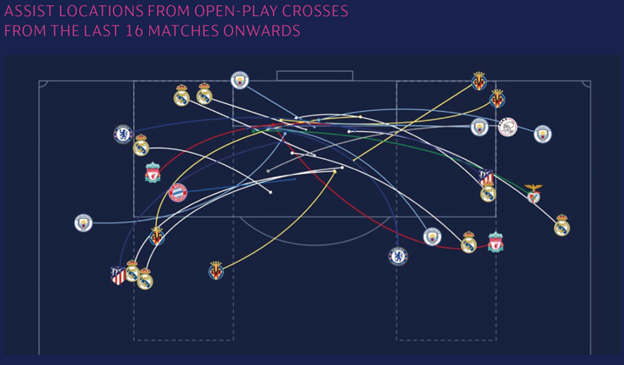
Following this, take a look at a similar visualization from the Euro 2020 Technical Report. Similarly, most assists again came from cutbacks and the half-spaces.

Ball-Playing and Progressing Center Backs
Across Europe, center backs who are technically skilled with the ball at their feet have become more and more valuable and are utilized more and more by top sides such as Liverpool and Manchester City in the build-up phase to begin building up from out the back. Center backs such as Laporte, Blind, Bonucci, Stones, Van Dijk, Maguire and Vertonghen have become known for their abilities to play a role in their teams’ build ups through their ability to carry and pass the ball forward and their ability to break lines of pressure from the opposition.
This was common in Euro 2020 where Bonucci, Laporte and Vertonghen formed the top 3 of center backs who broke 2+ lines through passes which Maguire followed closely behind, when in the England line up. It is important to also note that amongst all players in the tournament a center back was in the top 3 of players who most often broke 2+ lines through passes and that was Netherland’s Daley Blind.
Having center backs that are good with the ball at their feet can provide an additional source of creativity for teams but also help to invite pressure and create space in behind for teams while also potentially creating an overload against opposition presses when building up especially when the goalkeeper is involved. Expect to see a decent amount of teams building out the back in Qatar and pay attention to the importance of the center-backs in this process whether it is stepping into the midfield to create overloads, inviting pressure to create space in behind and/or playing passes the break opposition lines.
Tactical Chameleons
Who would have ever thought that a global pandemic would have an effect on football tactics? Well, that’s the case! Due to the pandemic and calendar congestion, we have seen the introduction of 5 substitutes instead of 3 and the expansion of squad lists from 23 to 26 players. These have had an effect on tactics where coaches have become more flexible and open to the idea of making changes both in games and in between games given the flexibility provided by expanded squads and more available substitutions.
The additional flexibility and importance of substitutes and their impact was seen throughout the 2021-22 UEFA Champions League, the Euro 2020 and the 2021 Copa America. For example, substitutes played a key part in Real Madrid’s success in the Champions League namely Eduardo Camavinga and Rodrygo who played key roles off the bench. Additionally, substitutes scored in 38% of knockout games in the Champions League. Federico Chiesa’s goal against Austria for Italy after coming off the bench in Euro 2020 in extra time can also not be forgotten.
In tournaments such as Copa America, Euros and the World Cup, it is a must to be tactically flexible in games and in between games given each result matters, there’s no room for error - especially in the knockout rounds. Recall, in the Round of 16 of the Euros, France went down 1-0 against Switzerland early where Deschamps changed from a 3-4-1-2 to a 4-4-2 diamond before half time then to an orthodox 4-4-2 after half time which saw France go 3-1 up before giving up the lead and getting knocked out on penalties. Similarly, Denmark started the tournament in a 4-3-3 then made the shift to the 3-4-2-1 and even shifted back to the 4-3-3 in game a few times. In Copa America, both the finalists in Argentina and Brazil demonstrated similar flexibility where Argentina would play between a 4-4-2 or a 4-3-3 depending on the game and the state of the game itself. This saw Argentina oftentimes attacking in the 4-3-3 mainly (sometimes 4-4-2) and defending in the 4-4-2. Brazil also changed formations game to game adapting to the needs of the game plan when considering the opposition being faced which saw Tite’s side line up in a 4-3-3, 4-2-3-1 and 4-4-2 throughout the tournament. Argentina in fact won the Copa America against Brazil because of their ability to adapt their game plan and be flexible against the Brazilians, especially after taking the lead where they sat in a mid/low block and conceded control of the game, which they often did not do through the tournament. It is the same manner in which Italy conceded their possession-based style of play against Spain in the Euro 2020 semi-finals regardless of being a possession oriented team throughout the tournament. The need to be flexible is therefore demonstrated and is going to be expected and needed for any team that is likely to make a run in Qatar given the knockout stage and the maximum potential number of games being only 7.
Note that a front five is not a “new” tactic and neither are ball playing center backs. The front five actually takes from one of the earliest formations created, by Herbert Chapman in the 1920s, the W-M (shown below).
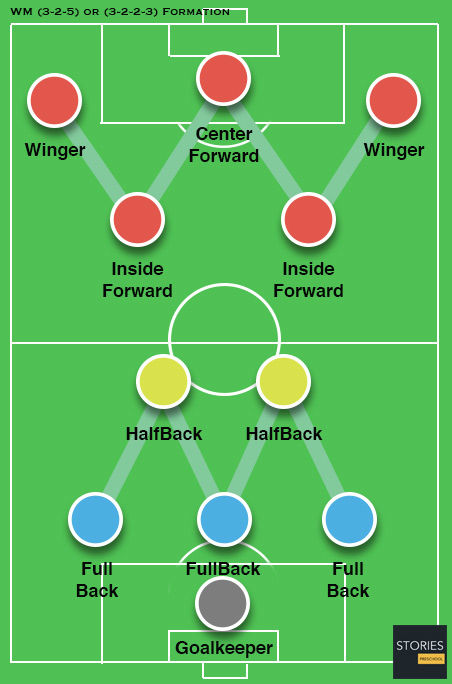
Additionally, it is interesting to see how in my 2014 World Cup Tactical Trends, sweeper keepers, partly for playing out the back, was discussed and that has now emerged to be ball playing center backs for 2022 which play a role with the sweeper keepers for teams building out the back. Meanwhile, in 2018 although not a tournament wide trend, I discussed England’s “Free 8s”, which now I expected to be a much more tournament wide trend in Qatar given what was discussed above. Therefore I will definitely circle back around after the tournament is over but you can expect me to be looking out for the following in the next few weeks:
4-3-3 and 3-4-3 variations dominating the tournament to form front fives through 2-3-5 or 3-2-5
Counter pressures through the front fives
Cutbacks and half-space crosses as key chance creation areas (especially low crosses)
Center backs progressing the ball through carries and line breaking passes as an additional source of creativity
Tactical flexibility in and in between games (including the willingness and ability to make effective substitutions and formation changes based on game state)


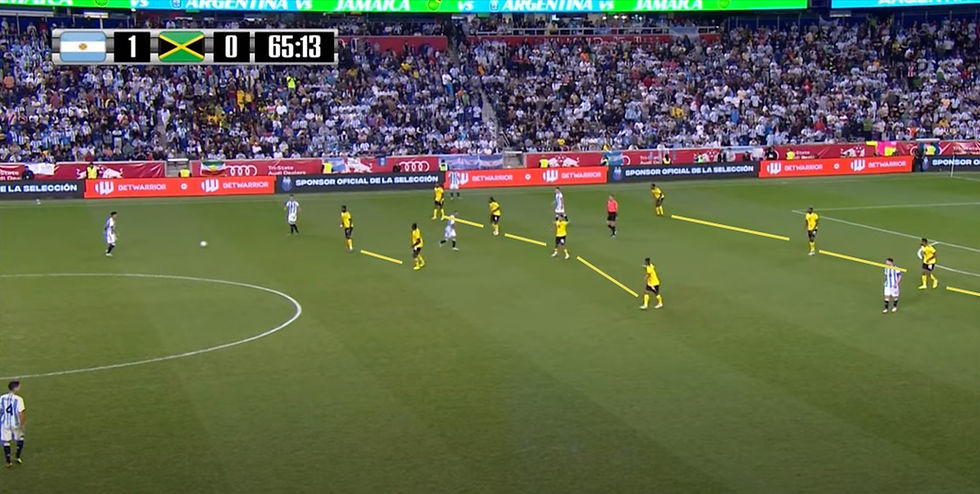

Comentarios